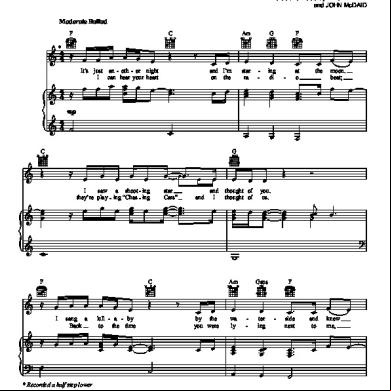K2 - Histology Of Urinary System.ppt 6j3h21
This document was ed by and they confirmed that they have the permission to share it. If you are author or own the copyright of this book, please report to us by using this report form. Report 3i3n4
Overview 26281t
& View K2 - Histology Of Urinary System.ppt as PDF for free.
More details 6y5l6z
- Words: 1,510
- Pages: 46
HISTOLOGY OF URINARY SYSTEM
Histology Departement FK USU August 2009
Urinary System: System Kidney, urinary ages ages include: Calyces Renal Pelvis Ureter Accessory parts include: Urinary bladder Urethra Kidney: Kidney Flattened, bean-shaped ~4.5 inches long Capsule: Capsule thin, fibrous, weakly attached (mostly collagenous fibers) Interstitial C.T. – scant; entirely reticular tissue Hilus: slit-like orifice – opens into expanded renal sinus, sinus a flattened cavity Renal sinus filled with: renal pelvis (expanded ureter); fat; C.T.; blood vessels; nerves
Kidney cross-section
Renal Pelvis: Subdivided into 2 or 3 major calyces Major calyces (1) subdivide into 7 – 10 minor calyces (2) Minor calyces fit over a renal papilla (3)
1 2
3
Kidney interior: largely parenchyma
Parenchyma: many long, tortuous secretory canals (nephrons) nephrons Excretory ducts of nephrons discharge into minor calyces Nephron + excretory duct = uriniferous tubule Parenchyma divisible into Cortex & Medulla Medulla (gray when fresh) composed of 10 – 15 renal pyramids 2 to 3 pyramids fuse: end in one papilla i.e., 6 to 14 papillae / kidney (human) Pyramids appear striate (tubules are straight) Cortex ( brownish in life) Inner border irregular Over base of pyramid; between pyramids (Renal columns of Bertin) Bertin
Nephron (Uriniferous Tubule) – Kidney is a compound gland Uriniferous tubule composed of two parts: Nephron & Collecting tubule
Nephron: The physiological unit of the kidney used for filtration of blood and reabsorption and secretion of materials Unbranched; 35 mm. long Includes straight portions & convoluted portions 1,300,000 tubules each kidney Collecting tubules part of a branched, tree-like system of excretory ducts tubules are straight Length: 21 mm. (each)
Nephrons
Parts of the Uriniferous Tubule Consecutive portions differ structurally & functionally (proximal means near the glomerulus & distal means nearer the papilla) The parts starting from the proximal end, taken in order: Nephron Glomerular capsule of Bowman Proximal Convoluted Tubule (including the straight portion = thick, descending segment of loop) Thin segment of Henle’s loop Thick, ascending segment of Henle’s loop Distal Convoluted Tubule The Excretory (= duct) Portion Arched Collecting Tubule (= junctional tubule) Straight Collecting Tubule Papillary Duct of Bellini
Henle’s
Uriniferous tubule segment locations are constant (recognizable regions) 3 primary topographical regions in kidney Cortical labyrinth Cortical ray Medulla In each region, 3 different tubular segments easily recognized (marked with asterisk) Cortical Labyrinth Glomerular capsule of Bowman* Proximal Convoluted Tubule* Thick, ascending segment of Henle’s loop Distal Convoluted Tubule* Arched Collecting Duct
Cortical Ray Straight portion of Proximal Convoluted Tubule* Thick Ascending Segment of Henle’s Loop* Straight Collecting Tubule*
Medulla Straight portion of Proximal Tubule (thick, descending segment of Henle’s Loop) Thin segment of Henle’s Loop* Thick, ascending segment of Henle’s Loop* Straight Collecting Tubule; Papillary Duct of Bellini*
Tubule Characteristics Epithelium is specific to each segment (tubule) Epithelium of excretory ducts is of one structural type All rest on a basement membrane
Renal (Malpighian) Corpuscle Spheroidal (0.2 mm. wide); Vascular glomerulus; Double-walled cup (nearly surrounds glomerulus) Glomerulus = rete mirabile afferent arteriole enters, forms many loops (smaller bore) efferent arteriole formed as loops unite; leaves glomerulus afferent & efferent arterioles enter & leave together at vascular pole
Renal Corpuscle
RENAL CORPUSCLE
Endothelium thin Tunica media of afferent arteriole modified near entry point Smooth muscle cells large, pale staining, lack myofibrils = a myo-epitheliod cuff, the juxtaglomerular cell Juxtaglomerular cell closely associated with macula densa of ascending limb
Juxtaglomerular apparatus: •Consists of JG cell, macula densa & mesangial cell (Lacis cell or Polkissen cell) •Functions in the regulation of blood pressure •Juxtaglomerular cells – secrete renin which activates angiotensin II (a vasoconstrictor)
Juxtaglomerular Apparatus
Glomerular Capsule Bowman’s Capsule – an epithelial cup Parietal (external) & visceral (internal) layer both are simple squamous epithelium cell boundaries; basement membrane - clear Layers are continuous Layers enclose space
Parietal & Visceral layers continuous Parietal layer
Visceral layer
Glomerulus & Sel Podosit
Renal Corpuscle and the Filtration Membrane
Neck – very short segment of tubule! Parietal layer opens into neck (urinary pole) pole Rapid epithelial change: flat capsular cells rise to cuboidal then to low columnar
Proximal Convoluted Tubule – longest (14 mm.), broadest (60 μ) tubule segment Most of bulk of pars convoluta (cortex) Remarkably contorted tubule! Location: Immediate vicinity of renal corpuscle Enters medullary (cortical) ray in ray to medulla Straightens in ray (= straight portion of proximal tubule or thick descending segment of Henle’s loop) Cells are low columnar Cell limits indistinct Nuclei: large, pale, spheroidal – 3 to 4 show in transverse section Free surface: brush border – resorpitive function
Thin Segment of Henle’s Loop Location: boundary zone of medulla Sharp transition from thick proximal tubule: reduced to 2 to 10 mm. long & 15 μ wide Resembles a capillary but is larger & thicker walled Short or long and recurved If this part extends past apex of loop: makes sharp hair-pin bend Interlocking cells – squamous with pale cytoplasm Brush border is absent Microvilli present (can see on EM) Nuclei flat, bulge into lumen Collecting Duct
Thin Segment Thick, descending limb
Apex of Henle’s Loop: A very sharp bend If loop is deep into medulla a long thin limb makes loop If loop is high in medulla the thick ascending segment is involved
Thick Ascending Segment of Henle’s Loop: Straight, radial tubule – 9 mm. long & 30μ wide Abrupt transition from thin limb into cuboidal epithelium Cells – more deeply acidophilic than those of thin limb Resemble cells of distal convoluted tubule = straight portion of distal tubule
Distal Convoluted Tubule ►Enters a ray – ascends ing into labyrinth ►Enclose to its glomerulus ►In wit juxtaglomerular cell : macula densa (cells taller, crowded, mass is elliptical)
Comparison of the tubule
Renal Pelvis – Ureter – Urinary Bladder Minor calyx caps each renal pyramid (7 to 10) Calyx is double walled cup Inner wall continuous with papillary ducts Several minor calyces open into each major calyx Major calyces open into renal pelvis Ureter connects renal pelvis to urinary bladder Mucosa of these elements: Transitional epithelium Calyx – 2 to 3 layers of cells Ureter – 4 to 5 layers of cells Urinary Bladder – 6 to 8 layers of cells Basement membrane not obvious
Lamina Propria – thin fibers, mostly collagenous No papillae Diffuse lymphoid tissue & occasional solitary lymph nodules Submucosa – vague or absent – deeper layers are looser, more elastic laxity permits folding Ureter has ~5 major and minor folds (stellate lumen) Relaxed bladder – mucosa thrown into thick, irregular folds
Muscularis – 2 to 3 layers loosely arranged layer (not compact) Smooth muscle – discrete bundles Inner layer – longitudinal Next layer – circular Bladder have 3rd layer (outermost) – longitudinal Pelvis & calyces – muscle is thin, largely circular (forms sphincter around each papilla) Adventitia – fibrous external tunic; blends with adjacent C.T.
Urethra – Female ♀ Urethra = short duct, 1.5 inches long From urinary bladder to outlet (in vestibule) Mucosa: Mucosa Epithelium
Near bladder = Transitional Middle portion (most of urethra): Pseudostratified to stratified columnar Near outlet = stratified squamous
Nest of mucous cells can occur Urethral glands (more numerous in males) Basement membrane: inconspicuous Lamina Propria: Propria no papillae; is folded longitudinally irregular lumen, crescent shaped
Submucosa Deep stratum rich in elastic fibers & veins (?) Layer may really be part of Lamina Propria Veins plexus of prominent, thin-walled vessels Spongy, semi-erectile tissue Muscularis Thick coat of smooth muscle Inner layer: longitudinal Outer layer: circular; forms internal involuntarysphincter near bladder Skeletal muscle exterior to smooth muscle = voluntary muscle “Constrictor Urethrae”
Adventitia indefinite coat (fuses to surrounding structures) Dorsally – merges with fibrous coat of vagina Other areas – fuses to constrictor urethrae muscle
Urethra – Male Tube ~8 inches long; stem only homologous to female urethra Three regional segments: Prostatic urethra: urethra next to bladder (1.5 inches long) elevated urethral crest (posterior wall) prostatic utricle & paired ejaculatory duct open on crest surrounded by prostate gland Membranous urethra: urethra prostate to penis (0.5 inches long) surrounded by muscles; components of urogenital diaphragm Cavernous urethra: urethra 6 inches through penis
Mucosa Epithelium varies regionally Transitional near bladder Most of urethra is stratified columnar or pseudostratified Near meatus: stratified squamous Epithelium on thin basement membrane Lamina Propria: resembles female L.P. branching mucous tubules (= Urethral Glands of Littré) ducts with intra-epithelial nest of mucous cells – open into recesses of lumen
Submucosa Not distinguishable as such Like ♀ -- deeper layer with many veins
Muscularis largely confined to prostatic & membranous segments inner layer (smooth muscle) – longitudinal outer layer (smooth muscle) – circular best developed at bladder neck – forms sphincter cavernous segment lacks smooth muscle layers longitudinal muscle – in true erectile tissue
Adventitia No typical adventitia present Prostatic urethra – surrounded by prostate gland Membranous urethra – encircled by sphincter of skeletal muscle Cavernous urethra surrounded by erectile tissue & dense outer sheath (neither belong to urethra)
The Histology of the Organs that Collect and Transport Urine
Figure 26.20a
REFERENSI ►Basic Histology : Junqueira ed.11 ►Human Histology ►Biology of Cell and Introduction to Pathology
Histology Departement FK USU August 2009
Urinary System: System Kidney, urinary ages ages include: Calyces Renal Pelvis Ureter Accessory parts include: Urinary bladder Urethra Kidney: Kidney Flattened, bean-shaped ~4.5 inches long Capsule: Capsule thin, fibrous, weakly attached (mostly collagenous fibers) Interstitial C.T. – scant; entirely reticular tissue Hilus: slit-like orifice – opens into expanded renal sinus, sinus a flattened cavity Renal sinus filled with: renal pelvis (expanded ureter); fat; C.T.; blood vessels; nerves
Kidney cross-section
Renal Pelvis: Subdivided into 2 or 3 major calyces Major calyces (1) subdivide into 7 – 10 minor calyces (2) Minor calyces fit over a renal papilla (3)
1 2
3
Kidney interior: largely parenchyma
Parenchyma: many long, tortuous secretory canals (nephrons) nephrons Excretory ducts of nephrons discharge into minor calyces Nephron + excretory duct = uriniferous tubule Parenchyma divisible into Cortex & Medulla Medulla (gray when fresh) composed of 10 – 15 renal pyramids 2 to 3 pyramids fuse: end in one papilla i.e., 6 to 14 papillae / kidney (human) Pyramids appear striate (tubules are straight) Cortex ( brownish in life) Inner border irregular Over base of pyramid; between pyramids (Renal columns of Bertin) Bertin
Nephron (Uriniferous Tubule) – Kidney is a compound gland Uriniferous tubule composed of two parts: Nephron & Collecting tubule
Nephron: The physiological unit of the kidney used for filtration of blood and reabsorption and secretion of materials Unbranched; 35 mm. long Includes straight portions & convoluted portions 1,300,000 tubules each kidney Collecting tubules part of a branched, tree-like system of excretory ducts tubules are straight Length: 21 mm. (each)
Nephrons
Parts of the Uriniferous Tubule Consecutive portions differ structurally & functionally (proximal means near the glomerulus & distal means nearer the papilla) The parts starting from the proximal end, taken in order: Nephron Glomerular capsule of Bowman Proximal Convoluted Tubule (including the straight portion = thick, descending segment of loop) Thin segment of Henle’s loop Thick, ascending segment of Henle’s loop Distal Convoluted Tubule The Excretory (= duct) Portion Arched Collecting Tubule (= junctional tubule) Straight Collecting Tubule Papillary Duct of Bellini
Henle’s
Uriniferous tubule segment locations are constant (recognizable regions) 3 primary topographical regions in kidney Cortical labyrinth Cortical ray Medulla In each region, 3 different tubular segments easily recognized (marked with asterisk) Cortical Labyrinth Glomerular capsule of Bowman* Proximal Convoluted Tubule* Thick, ascending segment of Henle’s loop Distal Convoluted Tubule* Arched Collecting Duct
Cortical Ray Straight portion of Proximal Convoluted Tubule* Thick Ascending Segment of Henle’s Loop* Straight Collecting Tubule*
Medulla Straight portion of Proximal Tubule (thick, descending segment of Henle’s Loop) Thin segment of Henle’s Loop* Thick, ascending segment of Henle’s Loop* Straight Collecting Tubule; Papillary Duct of Bellini*
Tubule Characteristics Epithelium is specific to each segment (tubule) Epithelium of excretory ducts is of one structural type All rest on a basement membrane
Renal (Malpighian) Corpuscle Spheroidal (0.2 mm. wide); Vascular glomerulus; Double-walled cup (nearly surrounds glomerulus) Glomerulus = rete mirabile afferent arteriole enters, forms many loops (smaller bore) efferent arteriole formed as loops unite; leaves glomerulus afferent & efferent arterioles enter & leave together at vascular pole
Renal Corpuscle
RENAL CORPUSCLE
Endothelium thin Tunica media of afferent arteriole modified near entry point Smooth muscle cells large, pale staining, lack myofibrils = a myo-epitheliod cuff, the juxtaglomerular cell Juxtaglomerular cell closely associated with macula densa of ascending limb
Juxtaglomerular apparatus: •Consists of JG cell, macula densa & mesangial cell (Lacis cell or Polkissen cell) •Functions in the regulation of blood pressure •Juxtaglomerular cells – secrete renin which activates angiotensin II (a vasoconstrictor)
Juxtaglomerular Apparatus
Glomerular Capsule Bowman’s Capsule – an epithelial cup Parietal (external) & visceral (internal) layer both are simple squamous epithelium cell boundaries; basement membrane - clear Layers are continuous Layers enclose space
Parietal & Visceral layers continuous Parietal layer
Visceral layer
Glomerulus & Sel Podosit
Renal Corpuscle and the Filtration Membrane
Neck – very short segment of tubule! Parietal layer opens into neck (urinary pole) pole Rapid epithelial change: flat capsular cells rise to cuboidal then to low columnar
Proximal Convoluted Tubule – longest (14 mm.), broadest (60 μ) tubule segment Most of bulk of pars convoluta (cortex) Remarkably contorted tubule! Location: Immediate vicinity of renal corpuscle Enters medullary (cortical) ray in ray to medulla Straightens in ray (= straight portion of proximal tubule or thick descending segment of Henle’s loop) Cells are low columnar Cell limits indistinct Nuclei: large, pale, spheroidal – 3 to 4 show in transverse section Free surface: brush border – resorpitive function
Thin Segment of Henle’s Loop Location: boundary zone of medulla Sharp transition from thick proximal tubule: reduced to 2 to 10 mm. long & 15 μ wide Resembles a capillary but is larger & thicker walled Short or long and recurved If this part extends past apex of loop: makes sharp hair-pin bend Interlocking cells – squamous with pale cytoplasm Brush border is absent Microvilli present (can see on EM) Nuclei flat, bulge into lumen Collecting Duct
Thin Segment Thick, descending limb
Apex of Henle’s Loop: A very sharp bend If loop is deep into medulla a long thin limb makes loop If loop is high in medulla the thick ascending segment is involved
Thick Ascending Segment of Henle’s Loop: Straight, radial tubule – 9 mm. long & 30μ wide Abrupt transition from thin limb into cuboidal epithelium Cells – more deeply acidophilic than those of thin limb Resemble cells of distal convoluted tubule = straight portion of distal tubule
Distal Convoluted Tubule ►Enters a ray – ascends ing into labyrinth ►Enclose to its glomerulus ►In wit juxtaglomerular cell : macula densa (cells taller, crowded, mass is elliptical)
Comparison of the tubule
Renal Pelvis – Ureter – Urinary Bladder Minor calyx caps each renal pyramid (7 to 10) Calyx is double walled cup Inner wall continuous with papillary ducts Several minor calyces open into each major calyx Major calyces open into renal pelvis Ureter connects renal pelvis to urinary bladder Mucosa of these elements: Transitional epithelium Calyx – 2 to 3 layers of cells Ureter – 4 to 5 layers of cells Urinary Bladder – 6 to 8 layers of cells Basement membrane not obvious
Lamina Propria – thin fibers, mostly collagenous No papillae Diffuse lymphoid tissue & occasional solitary lymph nodules Submucosa – vague or absent – deeper layers are looser, more elastic laxity permits folding Ureter has ~5 major and minor folds (stellate lumen) Relaxed bladder – mucosa thrown into thick, irregular folds
Muscularis – 2 to 3 layers loosely arranged layer (not compact) Smooth muscle – discrete bundles Inner layer – longitudinal Next layer – circular Bladder have 3rd layer (outermost) – longitudinal Pelvis & calyces – muscle is thin, largely circular (forms sphincter around each papilla) Adventitia – fibrous external tunic; blends with adjacent C.T.
Urethra – Female ♀ Urethra = short duct, 1.5 inches long From urinary bladder to outlet (in vestibule) Mucosa: Mucosa Epithelium
Near bladder = Transitional Middle portion (most of urethra): Pseudostratified to stratified columnar Near outlet = stratified squamous
Nest of mucous cells can occur Urethral glands (more numerous in males) Basement membrane: inconspicuous Lamina Propria: Propria no papillae; is folded longitudinally irregular lumen, crescent shaped
Submucosa Deep stratum rich in elastic fibers & veins (?) Layer may really be part of Lamina Propria Veins plexus of prominent, thin-walled vessels Spongy, semi-erectile tissue Muscularis Thick coat of smooth muscle Inner layer: longitudinal Outer layer: circular; forms internal involuntarysphincter near bladder Skeletal muscle exterior to smooth muscle = voluntary muscle “Constrictor Urethrae”
Adventitia indefinite coat (fuses to surrounding structures) Dorsally – merges with fibrous coat of vagina Other areas – fuses to constrictor urethrae muscle
Urethra – Male Tube ~8 inches long; stem only homologous to female urethra Three regional segments: Prostatic urethra: urethra next to bladder (1.5 inches long) elevated urethral crest (posterior wall) prostatic utricle & paired ejaculatory duct open on crest surrounded by prostate gland Membranous urethra: urethra prostate to penis (0.5 inches long) surrounded by muscles; components of urogenital diaphragm Cavernous urethra: urethra 6 inches through penis
Mucosa Epithelium varies regionally Transitional near bladder Most of urethra is stratified columnar or pseudostratified Near meatus: stratified squamous Epithelium on thin basement membrane Lamina Propria: resembles female L.P. branching mucous tubules (= Urethral Glands of Littré) ducts with intra-epithelial nest of mucous cells – open into recesses of lumen
Submucosa Not distinguishable as such Like ♀ -- deeper layer with many veins
Muscularis largely confined to prostatic & membranous segments inner layer (smooth muscle) – longitudinal outer layer (smooth muscle) – circular best developed at bladder neck – forms sphincter cavernous segment lacks smooth muscle layers longitudinal muscle – in true erectile tissue
Adventitia No typical adventitia present Prostatic urethra – surrounded by prostate gland Membranous urethra – encircled by sphincter of skeletal muscle Cavernous urethra surrounded by erectile tissue & dense outer sheath (neither belong to urethra)
The Histology of the Organs that Collect and Transport Urine
Figure 26.20a
REFERENSI ►Basic Histology : Junqueira ed.11 ►Human Histology ►Biology of Cell and Introduction to Pathology










